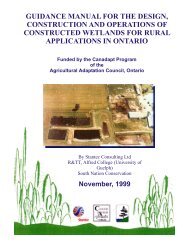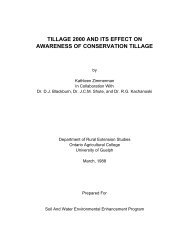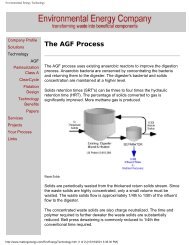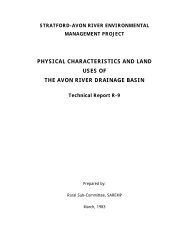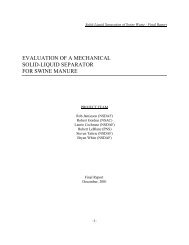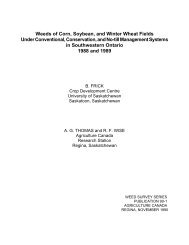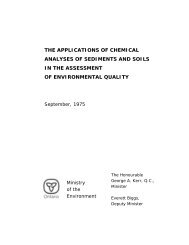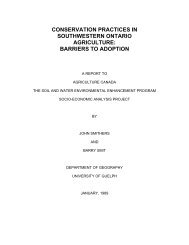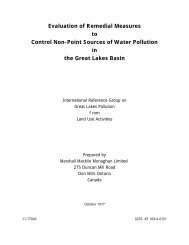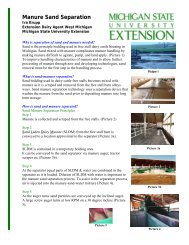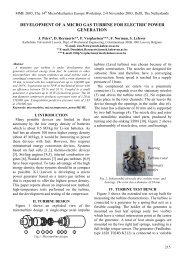Environmental Aspects of Phosphate and Potash Mining United ...
Environmental Aspects of Phosphate and Potash Mining United ...
Environmental Aspects of Phosphate and Potash Mining United ...
You also want an ePaper? Increase the reach of your titles
YUMPU automatically turns print PDFs into web optimized ePapers that Google loves.
The <strong>Environmental</strong> Approach <strong>of</strong> the <strong>Phosphate</strong> Rock <strong>and</strong> <strong>Potash</strong> <strong>Mining</strong> Industry<br />
Other impacts may include: wind-generated dust<br />
from fines tailings; adverse effects on wildlife; <strong>and</strong> the<br />
visual disturbance resulting from large elevated dams<br />
or tailings stacks.<br />
Waste Disposal Methods<br />
A wide variety <strong>of</strong> waste disposal methods are<br />
employed, including:<br />
Discharge <strong>of</strong> wastes to rivers <strong>and</strong> oceans. This may<br />
be accompanied by treatment to remove contaminants;<br />
Stacking wastes such as s<strong>and</strong> tailings <strong>and</strong> salt tailings<br />
in piles;<br />
Retention <strong>of</strong> wastes such as brines, s<strong>and</strong> tailings,<br />
magnetite tailings, clays <strong>and</strong> process water in dams<br />
or ponds for storage, settling <strong>and</strong> clarification;<br />
<br />
<br />
Backfilling <strong>of</strong> solid <strong>and</strong> liquid wastes into minedout<br />
underground openings;<br />
Deep well injection <strong>of</strong> brines.<br />
The methods used at a specific location are influenced<br />
by the characteristics <strong>of</strong> the waste <strong>and</strong> the site, <strong>and</strong> the<br />
regulating requirements.<br />
In some instances, liquid wastes such as brines, tailings,<br />
effluent or clay fines have been discharged to<br />
rivers or oceans. This may be done in a controlled<br />
manner using monitoring systems to ensure that levels<br />
<strong>of</strong> contaminants do not rise above prescribed levels<br />
<strong>and</strong> threaten the aquatic ecosystem. Treatment <strong>of</strong><br />
phosphate rock tailings effluent improves the quality<br />
<strong>of</strong> the release.<br />
28<br />
Riverine Brine Disposal<br />
Kali und Salz GmbH operate three potash operations in<br />
the Werra region <strong>of</strong> Germany: Hattorf; Unterbreizbach;<br />
<strong>and</strong> Wintershall. The operations extract a complex mineralized<br />
ore 'Hartsalz', that consists <strong>of</strong> a mixture <strong>of</strong><br />
sylvinite, carnallite, kieserite, <strong>and</strong> halite from a deeply<br />
buried potash deposit.<br />
The ore is beneficiated using both dry electrostatic separation<br />
<strong>and</strong> wet thermal dissolution separation<br />
processes to produce a variety <strong>of</strong> potassium <strong>and</strong> magnesium<br />
products. For each tonne <strong>of</strong> ore beneficiated,<br />
22% becomes product, while 78% becomes waste. The<br />
waste consists predominantly <strong>of</strong> salt tailings <strong>and</strong> magnesium<br />
chloride (MgCl 2 ) brines. The process employed<br />
allows the salt to be largely separated dry from potash,<br />
Figure 3.6.2<br />
Control <strong>of</strong> salt concentration in Werra River.<br />
Kali und Salz GmbH, Germany.<br />
Chloride<br />
content<br />
mg/l<br />
30000<br />
25000<br />
20000<br />
15000<br />
10000<br />
5000<br />
0<br />
producing dry salt tailings. On the other h<strong>and</strong>, magnesium<br />
chloride can only be separated from the potash in<br />
solution. This results in significant quantities <strong>of</strong> brine<br />
being produced.<br />
The salt tailings are generally conveyed to a salt stack on<br />
the surface for disposal. Some salt tailings are used to<br />
backfill carnallite rooms produced at the<br />
Unterbreizbach underground mining operation. Brines<br />
are disposed <strong>of</strong> by either deep well injection into a suitable<br />
pervious dolomite formation or discharged to the<br />
Werra <strong>and</strong> Ulster river system.<br />
Brine waste produced at each beneficiation plant is<br />
pumped to a series <strong>of</strong> lined retention ponds from which<br />
discharge occurs to the river system. The discharge is<br />
monitored <strong>and</strong> controlled using a computer system to<br />
ensure that the permitted salt concentration <strong>of</strong> 2.5<br />
grams per litre <strong>of</strong> river water is not exceeded as the river<br />
conditions <strong>and</strong> flow rate vary.<br />
The system prevents adverse effects on the aquatic<br />
ecosystem downstream.<br />
Brine retention ponds for controlled release to Werra River -<br />
Kali und Salz GmbH, Germany



